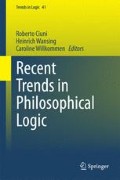Abstract
The objective of this paper is to introduce and motivate a new semantic framework for modalities. The first part of the paper will be devoted to defending the claim that conventional possible worlds are ill-suited for the semantics of certain types of modal statements. We will see that the source of this expressive limitation comes from what will be dubbed “worldly flatness”, the fact that possible worlds don’t determine modal facts. It will be argued that some modalities are best understood as quantifiers over modal facts and that possible worlds semantics cannot achieve this. In the second part of the paper, I will present a new semantic framework that allows for such an understanding of modalities.
Access this chapter
Tax calculation will be finalised at checkout
Purchases are for personal use only
Notes
- 1.
The term “flat” is sometimes used to mean that the modal facts supervene on the basic facts, as Humean supervenience would have it (cf. [8], p. 14). It seems that in this usage of the term, “flat” applies to the universe, whereas my flatness applies to single worlds.
- 2.
\(\fancyscript{T}\) is a tree iff \(<\) is an anti-reflexive, transitive and connected relation \(<\) on \(T\) such that, for all \(t\in T\), its restriction to \(\{s\in T : s\le t\}\) is linear. In a tree, there is only one path from right to left but possibly many from left to right.
- 3.
Note that “being a square” and “being a circle” are not properties of this universe.
- 4.
The reader can assume that the agents are immaterial and only have epistemic properties.
- 5.
These product frames are just a special case of what Gabbay and Shehtman [3] call “fibered semantics”, the general technique of mending two or more structures together to yield a further structure. Not all such combined structures have the property that the modalities have no interactions amongst themselves, thus some combined structures may actually turn out to have non-flat worlds. In fact, there is even reason to suspect that possibility spaces can be described as a special case of fibered semantics. However, since fibered semantics of this kind haven’t been explored to my knowledge, thinking in those terms will not be especially useful.
References
Blackburn, P., de Rijke, M., & Venema, Y. (2001). Modal logic, Cambridge tracts in theoretical computer science (Vol. 53). Cambridge: Cambridge University Press.
Davies, M., & Humberstone, L. (1980). Two notions of necessity. Philosophical Studies, 38, 1–30.
Gabbay, D., & Shehtman, V. B. (1998). Products of modal logics: part 1. Logic Journal of IGPL, 6(1), 73.
Gabbay, D., & Shehtman, V. B. (2000). Products of modal logics: part 2. Logic Journal of IGPL, 8(2), 165–210
Gabbay, D., & Shehtman, V. B. (2002). Products of modal logics: part 3. Studia logica, 72(2), 157–183
García-Carpintero, M., Macià, J. (Eds.). (2006). Two-dimensional semantics. Oxford: Oxford University Press.
Lewis, D. K. (1973). Counterfactuals. Oxford: Blackwell.
Lewis, D. K. (1986). On the plurality of worlds. Oxford: Blackwell.
Prior, A. (1967). Past, present and future. Oxford: Oxford University Press.
Segerberg, K. (1973). Two-dimensional modal logic. Journal of Philosophical Logic, 2(1), 77–96.
Acknowledgments
This work was supported by grant # 149410 of the FQRSC. I would like to thank audiences at Trends in Logic 2012 and Logica 2012, and I’m grateful for comments from Agustin Rayo.
Author information
Authors and Affiliations
Corresponding author
Editor information
Editors and Affiliations
Rights and permissions
Copyright information
© 2014 Springer International Publishing Switzerland
About this chapter
Cite this chapter
Kennedy, N. (2014). On the Essential Flatness of Possible Worlds. In: Ciuni, R., Wansing, H., Willkommen, C. (eds) Recent Trends in Philosophical Logic. Trends in Logic, vol 41. Springer, Cham. https://doi.org/10.1007/978-3-319-06080-4_9
Download citation
DOI: https://doi.org/10.1007/978-3-319-06080-4_9
Published:
Publisher Name: Springer, Cham
Print ISBN: 978-3-319-06079-8
Online ISBN: 978-3-319-06080-4
eBook Packages: Mathematics and StatisticsMathematics and Statistics (R0)

